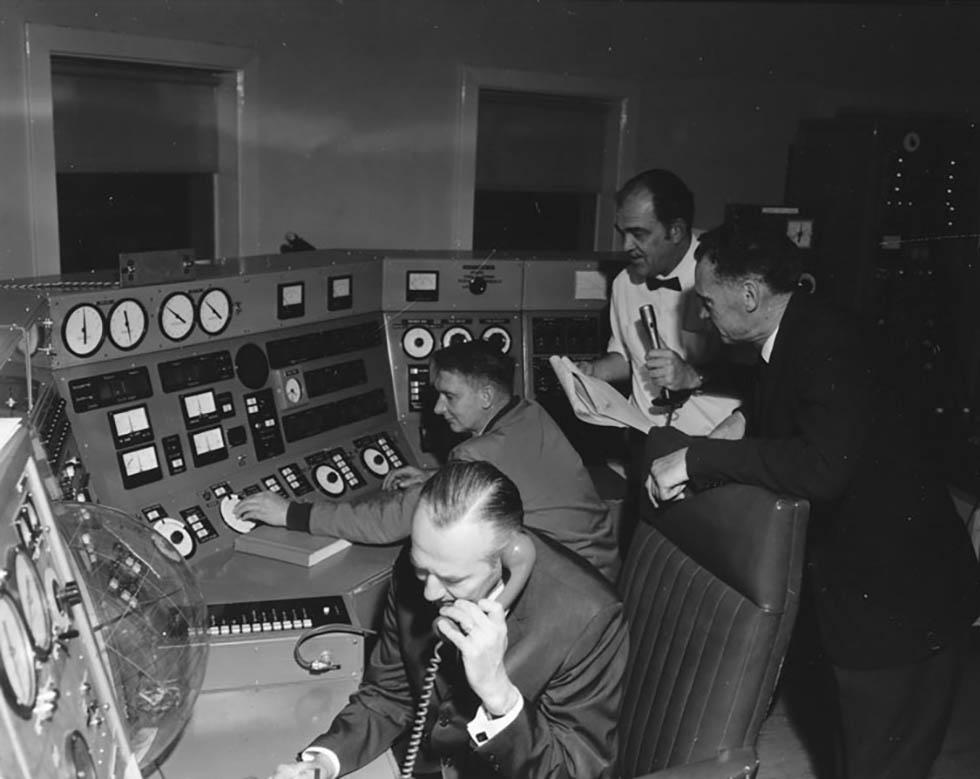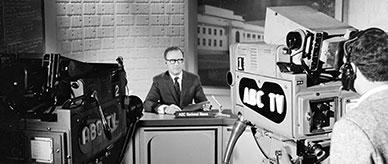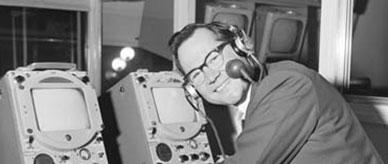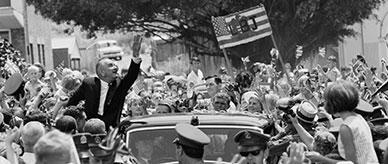


About this record
This is a black-and-white photograph of Australian and American scientists at Australia’s National Radio Astronomy Observatory at Parkes, New South Wales, during the Apollo 11 moon landing in July 1969. Four men are grouped in front of a bank of instruments and dials. From front to back are Willson Hunter, chief representative of the National Aeronautics and Space Administration (NASA) in Australia; Dr Edward George Bowen, Chief of the Division of Radiophysics at the Commonwealth Scientific and Industrial Research Organisation (CSIRO); John Gatenby Bolton, Director of the Parkes Observatory (adjusting the telescope’s controls); and Robert Taylor, NASA Operations Manager in Australia.
Educational value
- Millions of people in the world stopped and watched the remarkable televised images of men walking on the moon. This photograph records the role of Australia’s Parkes Observatory in the historic Apollo 11 moonwalk on Monday, 21 July 1969. Three tracking stations received simultaneous television signals of Neil Armstrong’s first steps on the moon: Parkes in central New South Wales, Honeysuckle Creek in the Australian Capital Territory and Goldstone in California, USA. After the first few minutes of the telecast, NASA considered the signal from Parkes to be the best and switched over to it for the remainder of the two-and-a-half-hour telecast.
- John Bolton is shown manipulating the dish. Together with Neil ‘Fox’ Mason, he was responsible for ensuring the telescope was centred on the source of the signal and maximising the signal strength, thus providing the best pictures.
- Robert Taylor was an American engineer who managed the NASA operations at Parkes. John Bolton and Robert Taylor met in February 1969 when the Australian Department of Supply was negotiating a contract with NASA for the use of the Parkes Observatory during the Apollo 11 mission. After concluding that the two could work well together, Bolton insisted that the proposed lengthy contract be reduced to one sentence: ‘The Radiophysics Division would agree to support the Apollo 11 mission’.
- Dr Edward George Bowen was the driving force behind the development of the radio telescope at Parkes. The telescope, 64 metres in diameter, was opened in 1961. Able to cover parts of the sky that could not be seen from the northern hemisphere, it was ideal for tracking deep space objects such as Apollo 11. The radio telescope at Parkes was the model design for NASA’s Deep Space Tracking Network.
- Willson Hunter is shown conferring on the telephone with NASA in Houston. He coordinated the network of NASA tracking stations across Australia. Honeysuckle Creek near Canberra, the main NASA tracking station, was to track the command module Columbia in lunar orbit, and Tidbinbilla was to track the lunar module Eagle on the lunar surface. The roles for Honeysuckle Creek and Tidbinbilla were later switched because of a fire in the transmitter at Tidbinbilla on 18 July. Carnarvon in Western Australia was also tracking the lunar module, while Narrabri in northern New South Wales was observing the sun and warning NASA of any impending solar flares.
- The photograph shows the control room of the Parkes Observatory during the extra-vehicular activity (EVA) known as ‘the moonwalk’. Immediately prior to the EVA, the control room was vibrating and swaying from 110-kilometre-per-hour winds—10 times stronger than the dish could safely withstand. The dish was also tilted at its most vulnerable zenith angle, in order to receive signals from the moon as soon as it rose over the horizon. At 12.54 pm Australian Eastern Standard Time—just as astronaut Buzz Aldrin activated the television camera—the control room’s alarms were ringing and the telescope was growling disturbingly overhead. But as the moon rose into the beam of the telescope, the winds slowly subsided, enabling the world to see men from Earth walking on the moon for the first time.
- Radio telescopes are so called because their dish-shaped receivers receive the radio waves emitted from celestial objects. These receivers focus and reflect the waves to another receiver suspended above the dish, which in turn amplifies the radio signals.
- Visible light covers only a small part of the range of wavelengths in which electromagnetic waves can be produced, and radio waves can travel much further as they have a greater wavelength. Astronomers have developed sophisticated systems to enable them to make pictures from radio waves.
Acknowledgments
Learning resource text © Education Services Australia Limited and the National Archives of Australia 2010.
Related themes
Need help with your research?
Learn how to interpret primary sources, use our collection and more.



